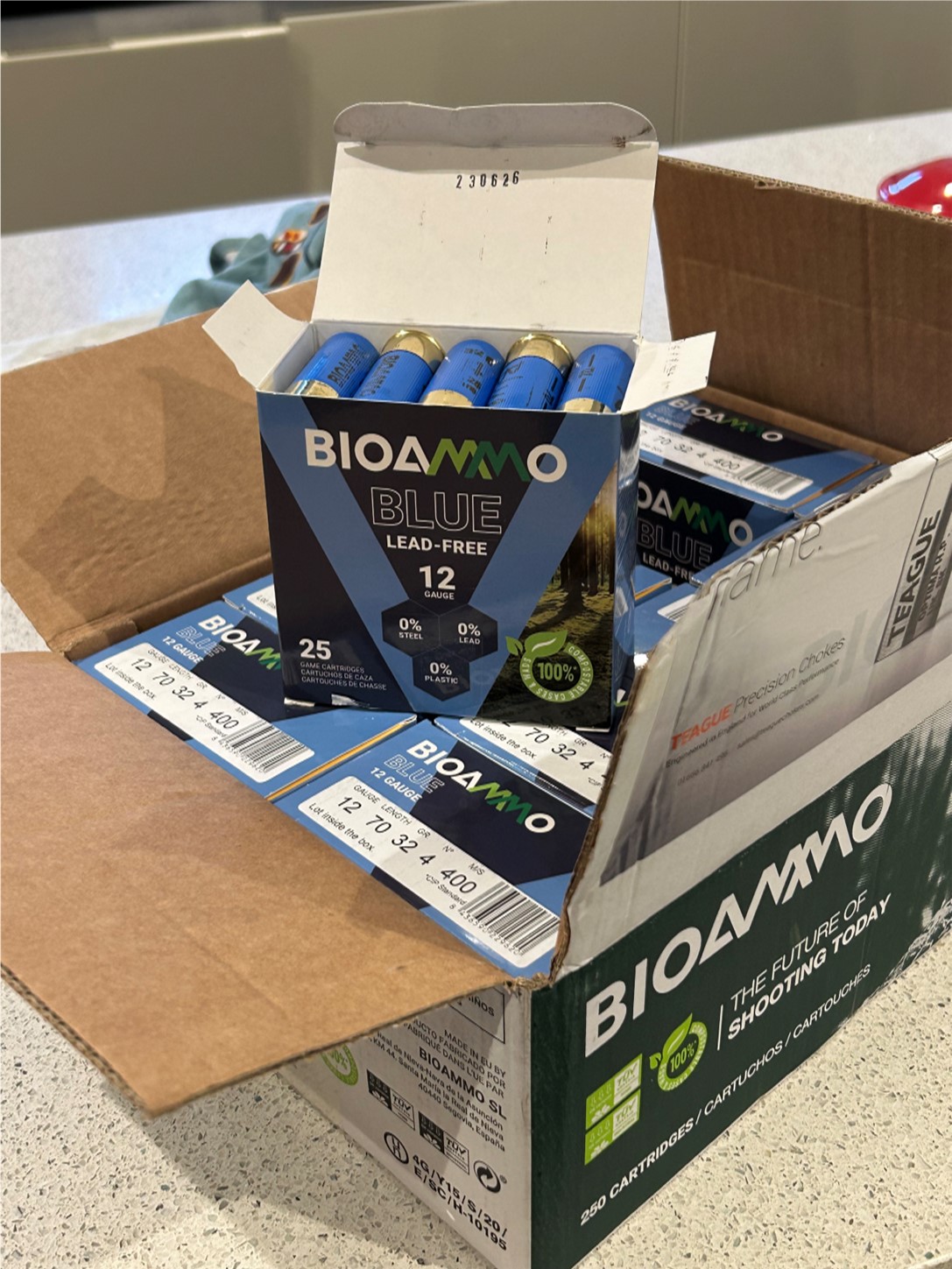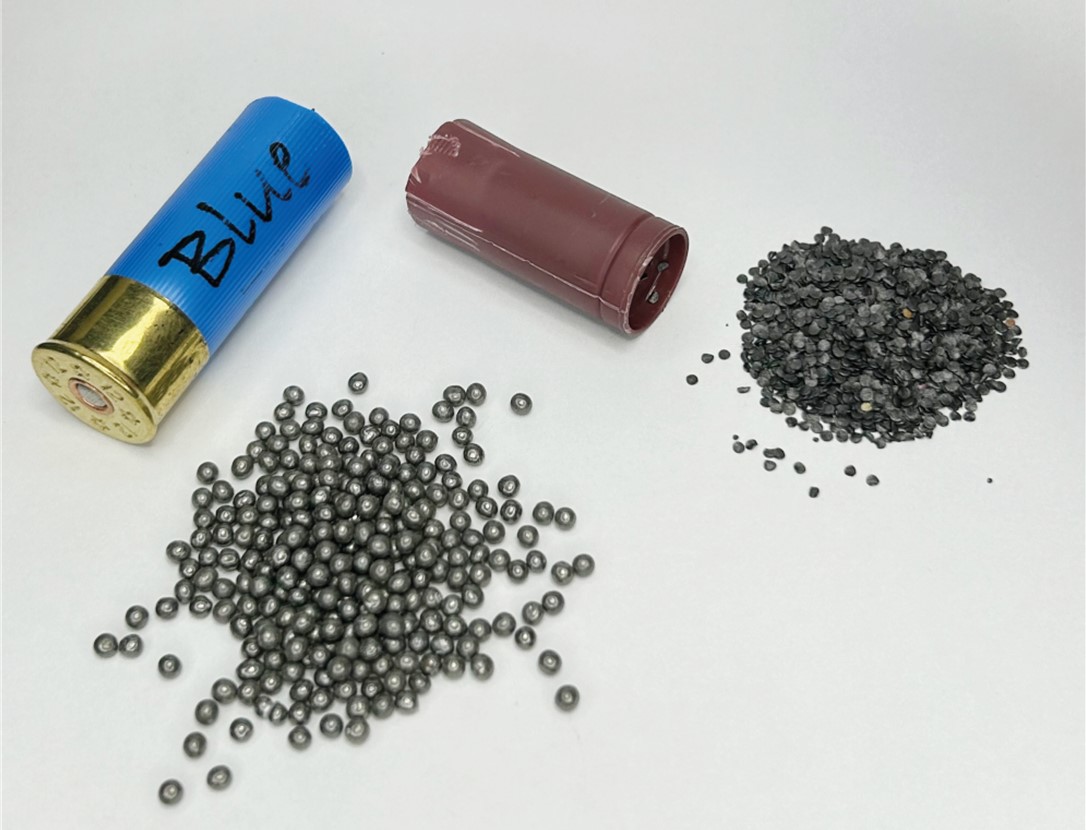I have been wanting to try Bioammo Blue cartridges for some time, for two main reasons. First, their eco credentials as a legal alternative to lead shot, and second, the fact that they can be shot through any shotgun with any fixed choke. However, I didn’t just want to shoot them at a pattern plate and tell you what I thought about them. I wanted to test them in the field, put them to use in the environment that they are designed for, and write the kind of review I’d be happy reading.
After all, cartridges are no longer cheap and these retail for around £224 for 250, which is definitely on the dear side compared with an equivalent steel-shot, biodegradable-wad cartridge at around £130 per slab – but still a third of the price of bismuth – so you need to know that they are worth the expense before parting with your cash.
 We may finally have an affordable alternative to bismuth
We may finally have an affordable alternative to bismuth
Any old guns?
Another reason for wanting to let you know how they perform is the constant conversations I have with fellow guns about what I’m going to do with all my old guns when the lead ban comes in and whether the bottom is going to fall out of the classic English gun market. Well it isn’t and this is why not.
I have tried over the past couple of years to explain that standard steel-shot cartridges (not high performance ) can be safely shot through any nitro-proofed shotgun as long as the chokes are no tighter than ½ choke, but it seems to fall on deaf ears. A bit like my “To see how they performed in the field I got hold of a slab of Bioammo 32g 4s, which should be ideal for wild duck”
We may finally have an affordable alternative to bismuthguns remembering their peg numbers after the first drive!
Now that’s all well and good, but what about an AYA side-by-side game gun or Cogswell & Harrison that is fixed choked ¾ & full? Your options in either of these cases is to have your gun’s chokes eased by a competent gun smith for around £300-400 or have Teague chokes fitted. The latter option would cost considerably more, and if you are only going to need ½ choke max (for steel) what’s the point of having interchangeable chokes?
That said, there is a further alternative. You could can use Bioammo Blue, which is why I have been keen to test these cartridges and see if there is any truth in the feedback I’ve been hearing from other guns that have used them.
 A double-base premium US-manufactured powder is used with Bioammo’s four- petal compostable bio-polymer wad
A double-base premium US-manufactured powder is used with Bioammo’s four- petal compostable bio-polymer wad
The Spanish-made Bioammo Blue cartridge has, in my opinion, gone down the route that other cartridge manufacturers should be travelling. The shot is made from a mixture of bismuth, aluminium, tin and zinc, producing performance that is similar to that of lead and can be shot through any choke constriction. On paper it appears to be the perfect lead alternative, which will be music to the ears of all classic gun collectors. Combined with a completely bio-degradable cartridge case and cup/wad, they would seem to be a winner.
 The proof is in the shooting. Clean kills at sensible distances
The proof is in the shooting. Clean kills at sensible distances
Performance
To see how they performed in the field I got hold of a slab of Bioammo 32g 4s, which should be ideal for wild duck, and took them out on one of our Marsh Wild Bird Syndicate days. We started before first light on the foreshore, with just three of us willing to get out of bed and relish the sheer pleasure of a dawn flight. I handed out a few boxes of Bioammo as I knew these guns could be relied on to give me a constructive, honest review of how it actually performed in the field. Henry was using his Denton & Kennel SBS choked ¼ & ½, Ben his Zabala SBS choked ½ & ½ and I had my Yildiz Pro Black choked ½ & ¾.
As dawn broke and the marsh began to waken with the sounds of teal, wigeon and mallard calling all around us, Henry was the first to shoot. Out to my right I saw the faint outline of a bird fall in the half light to his single shot. He’s a third my age, so it would be a while for there to be enough light for my poor old eyes to pick anything out.
As the light grew in the sky, a teal zipped over my right shoulder. I swung through it and dropped it over the sea wall with one barrel; Henry’s dog Gin was sent off for a tidy retrieve. Ben let off a couple of shots out of sight to my left as the marsh came alive with daybreak. We had a frenzied 90 minutes with plenty of shooting.
As things calmed down we gathered together to inspect the spoils of the morning’s flight. We had managed to bag six duck plus one Henry knew had been hit but had yet to be picked. The first thing Henry said as he walked over was, “Well, they certainly work!” Henry usually shoots bismuth on the marsh and was sceptical about trying the Bioammo, but all but one duck had been killed by a single shot, with just one runner. Recoil through my sporter was negligible and the others passed no comment on it.
As Gin was busy looking for the runner a flock of teal came towards me at a good height and as always I swung onto one and shot, but they continued on unscathed.
The light was perfect and Henry was in just the right position to see the shot string and commented that it looked like it just ran out of steam. They were high though, at least 50yd, but I often pull a few down at that height with 36g No. 3 steel. Perhaps I was being a little over optimistic with the Bioammo but it was interesting to hear Henry’s comment. That said, Henry had pulled down a corker earlier that morning that was all of 40yd out, so make of it what you will.
Testing ground
We gathered back at the pub with the rest of the guns, drew pegs for the day’s drives and I handed out some more Bioammo cartridges. The first drive was a belter, with flocks of teal, gadwall, mallard, snipe, pigeons and a solitary pheasant. It was the perfect test for the cartridges and it would seem that they are more than up to the job in hand.
Many of the guns in the syndicate use older side-by-sides, so an alternative to bismuth is welcome. With more cartridge manufacturers heading down the high- performance steel route to produce a shell for high-bird shoots, it is tricky and somewhat confusing to know which cartridges are compatible with your gun.
Reports from the guns were good and the Bioammo certainly killed well. After some 200 shots there was no mention of excessive recoil from anyone, so I can only assume it was not an issue. I had heard reports of the early cartridges being a little snappy, but I didn’t mention it to any one as I wanted a true unbiased review.
The other thing I find so good about these shells is that the entire cartridge is bio- degradable and 100% plastic free. I never find many cartridges on my shoot left by the guns, but it certainly is good to know that if you lose a couple on an evening flight they will not be there for eternity.
The bit that I really like is the bio wad.
No need to worry if you own a classic fixed-choke sidelock The number of wads I find on the marsh and beach on my morning dog walk is astonishing and I feel that bio-degradable wads are more important than the lead ban.
No-one should be shooting with plastic wads in this day and age. If our sport really wants to continue, and be seen to care about the environment we shoot in, we must make changes before we are forced to by law.
 No need to worry if you own a classic fixed-choke sidelock
No need to worry if you own a classic fixed-choke sidelock
Conclusions
I have not included any pattern plate info here because it is available online and the proof of the pudding is in the eating – or in this case in the field. There is no doubting that Bioammo Blue work well. They are lead free, can be used in any nitro-proofed gun and can be shot through any choke. They are not for high birds, as I have found in subsequent outings. In fact Bioammo state that they are effective out to 40yd, but that is still a good distance.
So what is my conclusion about Bioammo Blue? If you use a classic game gun or do not want to have your gun’s chokes adjusted to suit steel shot, or simply do not like steel cartridges, then Bioammo Blue ammunition is without doubt well worth taking a look at. They certainly kill cleanly and pose no danger to your gun, whether it is a valuable old English sidelock or a much loved Spanish game gun. What’s more, they are available for 67mm, 70mm & 76mm ( 3" ) chambers and in 25, 28, 30, 32 and 35g for 12-bore guns, with 20-bore coming soon. I will certainly have a slab on my shopping list for use in my AYA No.1.